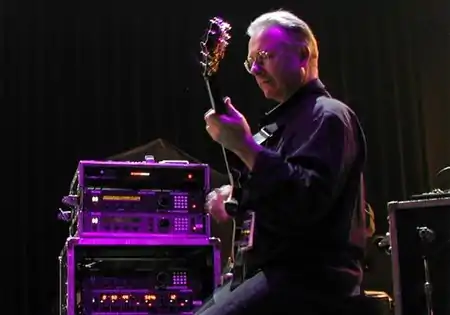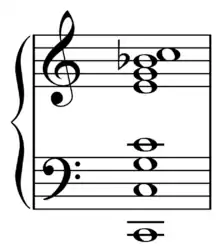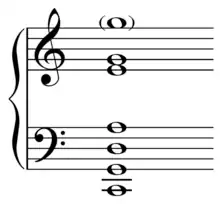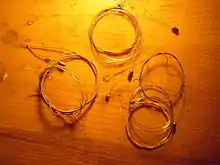New standard tuning
New standard tuning (NST) is an alternative tuning for the guitar that approximates all-fifths tuning. The guitar's strings are assigned the notes C2-G2-D3-A3-E4-G4 (from lowest to highest); the five lowest open strings are each tuned to an interval of a perfect fifth {(C,G),(G,D),(D,A),(A,E)}; the two highest strings are a minor third apart (E,G).
| New standard | |
|---|---|
 Five consecutive open-notes of new standard tuning are spaced seven semitones apart on the chromatic circle; the highest interval is only three semitones apart. | |
| Basic information | |
| Aliases | Guitar Craft tuning |
| Interval | Perfect fifth |
| Semitones | 7 |
| Example(s) | C-G-D-A-E-G |
| Advanced information | |
| Repetition | No |
| Advantages | Approximates all-fifths tuning; wide range |
| Disadvantages | Very difficult to play standard-guitar music |
| Left-handed tuning | All-fourths tuning (approximately) |
| Associated musician | |
| Guitarist | Robert Fripp |
 | |
| Robert Fripp has taught new standard tuning to three-thousand Guitar Craft students | |
| Regular tunings (semitones) | |
| Trivial (0) | |
| Minor thirds (3) | |
| Major thirds (4) | |
| All fourths (5) | |
| Augmented fourths (6) | |
| New standard (7, 3) | |
| All fifths (7) | |
| Minor sixths (8) | |
| Guitar tunings | |
All-fifths tuning is typically used for mandolins, cellos, violas, and violins. On a guitar, tuning the strings in fifths would mean the first string would be a high B. NST provides a good approximation to all-fifths tuning. Like other regular tunings, NST allows chord fingerings to be shifted from one set of strings to another.
NST's C-G range is wider, both lower and higher, than the E-E range of standard tuning in which the strings are tuned to the open notes E2-A2-D3-G3-B3-E4. The greater range allows NST guitars to play repertoire that would be impractical, if not impossible, on a standard-tuned guitar.
NST was developed by Robert Fripp, the guitarist for King Crimson. Fripp taught the new standard tuning in Guitar Craft courses beginning in 1985, and thousands of Guitar Craft students continue to use the tuning. Like other alternative tunings for guitar, NST provides challenges and new opportunities to guitarists, who have developed music especially suited to NST.
NST places the guitar strings under greater tension than standard tuning. Standard sets of guitar strings do not work well with the tuning as the lowest strings are too loose and the highest string may snap under the increased tension. Special sets of NST strings have been available for decades, and some guitarists have assembled NST sets from individual strings.[1]
History

New standard tuning (NST) was invented by Robert Fripp of the band King Crimson in September 1983.[2][3]
"I was in the Apple Health Spa on Bleecker and Thompson back in September 1983, in the sauna at half past 10 in the morning, almost asleep, and the tuning flew over my head. At the time I couldn’t understand what it was for. I was asked to give a guitar seminar at Claymont Court in December 1994, to raise funds for the running of the estate and the children’s school. There was a click and I realized the tuning was for the guitar class."[4]
Fripp began using the tuning in 1985 before beginning his Guitar Craft seminars,[5][6] which have taught the tuning to three thousand guitarists.[7]
| String (right-handed) | Note | Frequency (hertz) |
|---|---|---|
| 1 | g' | 392.00 |
| 2 | e' | 329.63 |
| 3 | a | 220.00 |
| 4 | d | 146.83 |
| 5 | G | 98.66 |
| 6 | C | 65.41 |
The tuning is (from low to high): C2-G2-D3-A3-E4-G4. The original version of NST was all-fifths tuning. However, in the 1980s, Fripp never attained the all-fifth's high B. While he could attain A, the string's lifetime distribution was too short. Experimenting with a G string, Fripp succeeded. "Originally, seen in 5ths all the way, the top string would not go to B. so, as on a tenor banjo, I adopted an A on the first string. These kept breaking, so G was adopted."[6] In 2012, Fripp suggested that Guitar Circle members experiment with an A string (0.007) from Octave4Plus of Gary Goodman;[8][9][10] if successful, the experiment could lead to "the NST 1.2", C2G2D3A3E4-A4, according to Fripp.[8] In 2010, Fripp suggested renaming the tuning as "Guitar Craft Standard Tuning or C Pentatonic tuning".[11]
Properties

The lowest five strings are tuned in perfect fifths from a low C. The first string is a minor third up from the E to a G. Since the lowest five strings are tuned in fifths, guitars with NST can be played with the fingerings for chords and scales used on the violin, cello, and mandolin.[12]
The first five strings of NST have all-fifths tuning, and so its all-fifths chords are movable around the fretboard. In contrast, standard tuning has an irregular major-third interjected among its perfect fourths, which complicates the learning of chords by beginners.[13]
The distinct open-notes {C,G,D,A,E} are the notes of the major pentatonic scale on C, which contains only consonant intervals. The C-pentatonic scale omits the open B of standard tuning and all-fifths tuning, which forms a dissonant second-interval with C. With the 1980s King Crimson, Fripp had used pentatonic harmony in "Discipline", "Thela Hun Ginjeet", and "Sartori in Tangier".[14]
Harmonics: Overtones

"With a note of music, one strikes the fundamental, and, in addition to the root note, other notes are generated: these are the harmonic series.... As one fundamental note contains within it other notes in the octave, two fundamentals produce a remarkable array of harmonics, and the number of possible combinations between all the notes increases phenomenally. With a triad, affairs stand a good chance of getting severely out of hand."
New standard tuning lists four notes (C,G,E,G) from the harmonic sequence (overtones) for the note C.[15] When the low open-note C-string is struck, its harmonic sequence begins with the notes
- (C,C,G,C,E,G,B♭,C).[16]
To strengthen a given chord, Vincent Persichetti's Twentieth-century harmony recommends adding perfect fifths above the initial overtones, rather than adding higher overtones, such as B♭ and the higher C.[16][17] Persichetti's book influenced Fripp.[18] In new standard tuning
- C is the fundamental overtone,
- G as a fifth reinforces C,
- D as a fifth reinforces G,
- A as a fifth reinforces D,
- E both as a fifth reinforces A and as the fifth overtone reinforces C, and
- G as the sixth overtone reinforces C.
Range

Like all-fifths tuning,[12] NST has a greater range than the standard tuning, a perfect fifth greater (a major third lower and a minor third higher).
Chords: Perfect intervals rather than thirds
Asked whether NST facilitates "new intervals or harmonies that aren't readily available in standard tuning", Fripp responded, "Yes, that's part of it. It's more effective. It's a more rational system, but it's also better sounding—better for chords, better for single notes." To build chords, Fripp uses "perfect intervals in fourths, fifths and octaves", so avoiding minor and major thirds.[2][19] Quartal and quintal harmony was stressed from the beginning of Fripp's teaching of Guitar Craft. Fripp began a 1986 course with these directions: "Now, pick a note from the following series—[it was a series of fourths or fifths]. When you are ready—do not be in any hurry, but when you are ready play your note, then pick others and play them as the situation demands it. Your first note will be the first intentional note you have played in a week."[20]
It is a challenge to adapt conventional guitar chords to new standard tuning.[20] NST has wider intervals between consecutive strings than standard tuning.[12]
"Most songs (that is music which has both words and instrumental accompaniments) written in the [NST] have a quality of walking on long stilts. There are rarely many intervals, harmonic or melodic, in these guitar accompaniments that are closer than a major third except in the top of the voicing. Close voicings (from a single guitar) in [NST] are possible thanks to the minor third between the first and second string, and this is often the only practical place where close voicings occur with any regularity".[15]
Historical background
Modern quartal and quintal harmony revives the polyphonic traditions of medieval Europe. Before the common practice period, European polyphony emphasized unison intervals and octaves and also perfect fifths. From the Renaissance to 1900, Western symphonic music was diatonic, emphasizing the tertian harmony of major and minor scales, keys, and chords.[21] Much popular music, especially rock, retains diatonic harmony.
String gauges

With traditional guitar strings, the low C may be loose and the high G may be too tight. Special gauges are therefore more suitable for NST. For steel-stringed acoustic-guitars, many Guitar-Craft participants use either an .011–.058 inch set[5] or an .011–.059 inch set;[22] string-sets may be purchased as a set from a manufacturer or purchased singly and assembled by the guitarist.
| G 1 | E 2 | A 3 | D 4 | G 5 | C 6 | Distributor |
|---|---|---|---|---|---|---|
| 0.011 | 0.013 | 0.023 | 0.032 | 0.046 | 0.056 | Guitar Craft Services[20] (Unavailable in 2012) |
| 0.012 | 0.015 | 0.023 | 0.032 | 0.046 | 0.060 | Guitar Craft Services[20] (Unavailable in 2012) |
| 0.011 | 0.013 | 0.022 | 0.032 | 0.047 | 0.058 | John Pearse Strings, manufacturer[23][24] |
| 0.011 | 0.013 | 0.022 | 0.032 | 0.047 | 0.059 | D'Addario, manufacturer[22][24] (available at Guitar-Circle courses)[24] |
| 0.010 | 0.052 (light) | Newtone Strings[25] | ||||
In 2012, a 0.007 inch gauge was being evaluated by Fripp and other members of Guitar Circle, who are considering replacing the first string's G note with an A note, the better to approximate the B note of all-fifths tuning. The 0.007 inch gauge was produced by Octave4Plus of Gary Goodman.[8][9][26] Robert Fripp uses lighter strings for electric guitar.[27]
| G 1 | E 2 | A 3 | D 4 | G 5 | C 6 | Reference |
|---|---|---|---|---|---|---|
| 0.010 | 0.012 | 0.016 | 0.024 | 0.038 | 0.052 | Robert Fripp[27][28] |
| 0.008 | 0.012 | 0.015 | 0.026 | 0.042 | 0.052 | Curt Golden[24] |
| 0.0085 | 0.010 | 0.015 | 0.024 | 0.038 | 0.056 | Fabio Mittino[29] |
Artists who use NST

Robert Fripp has used the New Standard Tuning since 1984.
Fripp has taught NST in his Guitar-Craft courses. In Guitar Craft and since 2010 in the successor Guitar Circles, students use only New Standard Tuning. Having to use a new tuning, the students are challenged to approach their playing with greater mindfulness, putting to rest their habitual use of automatic chords or licks. With the new tuning, guitarists have to find new ways of musical expression.[30]
The tuning is used by students of Guitar Craft, of which there have been three thousand. Guitar-Craft alumni who continue to practice NST are called "crafty guitarists" or "crafties".[7] Some crafty guitarists formed The League of Crafty Guitarists (LCG), which toured with Robert Fripp and released several albums.[31] The Guitar-Craft experience and the League of Crafty Guitarists trained guitarists who went on to form new bands, such as the California Guitar Trio[32] and Trey Gunn; the California Guitar Trio and Gunn toured with Fripp as The Robert Fripp String Quintet. Other alumni of the League of Crafty Guitarists include members of Los Gauchos Alemanes, such as U.S. guitarist Steve Ball;[33] Ball is associated with the Seattle Guitar Circle,[34] along with LCG alumnus Curt Golden.[35] The collection A Plague of Crafty Guitarists features the following Guitar-Craft alumni, who were listed in a review by Barry Cleveland: Tobin Buttram, Nigel Gavin, Geary Street Quartet, Bill Hibbits, Janssen and Jensen, Alejandro Miniaci[36] and From Power Trio /Project , Sur Pacifico, Playmovil, and Santos Luminosos.[37][38] NST has been adapted for instruments besides guitar. Italian guitarist Fabio Mittino plays in NST. Trey Gunn (Crimson's warr guitar player from 1994 to 2003) and Markus Reuter (TUNER with Crimson drummer Pat Mastelotto)[39] have adapted NST for their 8- and 10-string instruments; in 2007 Reuter used a B♭-F-C-G-D-A-C-D tuning.[39] Finnish musician Heikki Malmberg uses a 7-string guitar tuned in NST with an additional low F.[40] Additionally, British musician Michael Linden West plays the oud in NST.
See also
Notes
- Brian Robinson, composer
- Mulhern (1986)
- Tamm (2003, p. 148)
- Pareles, Jon (19 September 2022). "Robert Fripp Lightens Up". The New York Times. Retrieved 20 September 2022.
- Baldwin, Douglas (November 2007). "Guitar Heroes: How to Play Like 26 Guitar Gods from Atkins to Zappa", edited by Jude Gold and Matt Blackett, Guitar Player, p.111.
- Fripp, Robert. "Robert Fripp's diary: Friday, 5th February 2010". Discipline Global Mobile, DGM Live. Archived from the original on 25 February 2010.
- Fripp (2011, p. 3)
- Fripp, Robert. "Robert Fripp's diary: Sunday, 22nd April 2012". Discipline Global Mobile, DGM Live. Archived from the original on 11 November 2013. Retrieved 17 January 2013.
{{cite journal}}: Cite journal requires|journal=(help) - Fripp, Robert. "Robert Fripp's diary: Friday, 2nd March 2012". Discipline Global Mobile, DGM Live. Archived from the original on 23 September 2015. Retrieved 17 January 2013.
{{cite journal}}: Cite journal requires|journal=(help) - Octave4Plus of Gary Goodman
- Fripp, Robert. "Robert Fripp's diary: Monday, 4th January 2010". Discipline Global Mobile, DGM Live. Archived from the original on 21 March 2016. Retrieved 17 January 2013.
{{cite journal}}: Cite journal requires|journal=(help) - Sethares (2001, "The mandoguitar tuning", pp. 62–63)
- Sethares (2001, Regular tunings, p. 52)
- Tamm (2003, "Chapter nine: King Crimson IV and Andy Summers")
- Ball, Steve (3 January 2006). "Steve Ball music diary - Tuesday, January 03, 2006". Steve Ball at AllMusic. Retrieved 29 February 2012.
- Persichetti (1961, pp. 23–24)
- Fripp, Robert. "Robert Fripp's diary:Sunday, 11th March 2001". Discipline Global Mobile, DGM Live.
{{cite journal}}: Cite journal requires|journal=(help) - Tamm (2003, Chapter Two: The guitarist and the practice of music)
- Major thirds and minor thirds are implemented poorly in equal temperament tuning (in comparison to thirds in just intonation).
Gold, Jude (1 December 2005). "Just desserts: Steve Kimock shares the sweet sounds of justly tuned thirds and sevenths". Guitar Player. Master class. - Musicologist Eric Tamm wrote that despite "considerable effort and search I just could not find a good set of chords whose sound I liked" for rhythm guitar. (Tamm 2003, Chapter 10: Postscript)
- Persichetti (1961, "Chapter Four: Chords by fourths", p. 93)
- Barry (2004)
- Pearse, John. "Six and twelve string acoustic guitar". jpstrings.com. Retrieved 25 March 2012.
- Golden, Curt (30 September 2008). "Tunings". Curt Golden—Guitar Instruction. Retrieved 25 March 2012.
- Fripp, Robert (18 October 2012). "Robert Fripp's diary: October 18th, 2012". Discipline Global Mobile, DGM Live!. Archived from the original on 24 June 2015. Retrieved 7 November 2012.
- Fripp, Robert (2 August 2012). "Robert Fripp's diary: Thursday, 2nd August 2012". Discipline Global Mobile, DGM Live!. Archived from the original on 24 June 2015. Retrieved 19 August 2012.
- Fripp, Robert (18 March 2003). "Robert Fripp's diary: Tuesday, 18th March 2003". Discipline Global Mobile, DGM Live!. Archived from the original on 24 June 2015. Retrieved 23 July 2012.
- The scale of Fripp's guitar is 628 millimetres (24.7 in).
Crowe, Ben. "Custom guitars from Crimson Guitars UK currently in stock". Crimson Guitars. Retrieved 23 July 2012.
- <this string gauge provide almost the same tension for each string (G 7.23kg, E 7.07kg, A 7.08kg, D 6.88kg, G 7.47kg, C 7.24kg on D'Addario Strings). Fabio Mittino is a crafty who plays with Bert Lams from California Guitar Trio
- Tamm (2003, pp. 134, 142, 148 (Chapter 10), c.f. pp. 160, 4)
- Tamm (2003, Chapter 11)
- Zwerdling (1998)
- Cleveland, Barry (1 October 2005). "Electric Gauchos' transcontinental alt-prog". Guitar Player. Retrieved 25 March 2012.
- Anonymous, Yakima Herald-Republic (2000). "Guitar performance slated for Unity Church (Body and soul: What's happening)". Yakima Herald-Republic. Archived from the original on 25 February 2016. Retrieved 22 April 2012.
- Upchurch, Michael (6 October 2010). "Guitarists put listeners in the circle". The Seattle Times. Your Wednesday. Seattle, Washington. Archived from the original on 22 February 2016. Retrieved 25 March 2012.
- "Alejandro Miniaci Guitar Loops - Bio".
- Cleveland (2004a)
- Plague of Crafty Guitarists, Volume 1 at AllMusic. Retrieved 24 April 2012.
- Prasad, Anil (1 October 2007). "Markus Reuter". Guitar Player. RIFFS: Outsider. Retrieved 25 March 2012.
- Bender, Frank (25 April 2009). "Heikki Malmberg—Exclusive OnlineDrummer.com Interview". OnlineDrummer.com. Archived from the original on 10 November 2011. Retrieved 23 April 2012.
References
- Cleveland, Barry (1 August 2004a). "The Plague of Crafty Guitarists: Volume one". Guitar Player. Archived from the original on 22 February 2016. Retrieved 25 March 2012.
- Cleveland, Barry (1 December 2004). "California Guitar Trio (Interview)" (PDF). Frets Magazine (Fall). Guitar Player (subscription required). Retrieved 25 March 2012.
- Fripp, Robert (2011). Pozzo, Horacio (ed.). Seven Guitar Craft themes: Definitive scores for guitar ensemble. "Original transcriptions by Curt Golden", "Layout scores and tablatures: Ariel Rzezak and Theo Morresi" (First limited ed.). Partitas Music. ISMN 979-0-9016791-7-7. DGM Sku partitas001.
- Mulhern, Tom (January 1986). "On the discipline of craft and art: An interview with Robert Fripp". Guitar Player. 20: 88–103. Retrieved 8 January 2013.
- Persichetti, Vincent (1961). Twentieth-century harmony: Creative aspects and practice. New York: W. W. Norton. ISBN 0-393-09539-8. OCLC 398434.
- Sethares, William A. (2011). "Alternate tuning guide". Madison, Wisconsin: University of Wisconsin; Department of Electrical Engineering. 2010 PDF version by Bill Sethares. Retrieved 19 May 2012.
- Tamm, Eric (2003) [1990], Robert Fripp: From crimson king to crafty master (Progressive Ears ed.), Faber and Faber (1990), ISBN 0-571-16289-4, Zipped Microsoft Word Document, archived from the original on 26 October 2011, retrieved 25 March 2012
- Zwerdling, Daniel (5 September 1998). "California Guitar Trio". All Things Considered (NPR Weekend ed.). Washington DC: National Public Radio. Html transcription (subscription required). Audio recording (free). Archived from the original on 10 October 2014. Retrieved 25 March 2012.
Further reading
- Drozdowski, Ted (February 1989). "Robert Fripp: A plectral purist answers the dumb questions". Musician: 28+. Referenced in Tamm (2003).
External links
- Courses in New Standard Tuning are offered by Guitar Circle, the successor of Guitar Craft:
- The FraKctured Zone is a King Crimson fan website with notation and tabs to songs in NST (with acknowledgment to Trey Gunn for permission).
- Wolfowitz, Kiefer (2013). "Harmonization of diatonic major scale on C; Progressions of chords: Triads and sevenths". New Standard Tuning C-G-D-A-E-G of Robert Fripp's Guitar Craft (PDF). Wikimedia Foundation. Retrieved 8 November 2013.